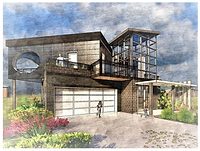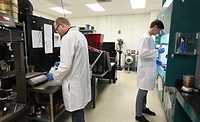X-MAT Receives $1.5 Million Federal Grant to Develop Coal Roof Tiles

The X-TILE™ is lightweight, fireproof and can withstand extreme temperatures. Photo courtesy of X-MAT.
ORLANDO, Fla. — X-MAT, the advanced materials division of Semplastics, has been awarded a $1.5 million grant from the Department of Energy’s National Energy Technology Laboratory (NETL) to continue the research and development of its coal roof tile the X-TILE™.
This award is a follow-on grant that will be used to expand on a previous grant the company received from the NETL, which focused on coal core composites for low cost, light weight, fire resistant panels and roofing materials.
This grant provides the funding necessary to move this technology towards commercialization by building a pilot manufacturing line in Bluefield, W.Va., and developing avenues for providing tiles with different colors, finishes and textures. In total, X-MAT has been awarded $3 million to fund its work with coal roof tiles.
“The X-TILE is coal reimagined,” said Bill Easter, founder of X-MAT and Semplastics. “We’re honored to receive this follow-on grant from the DOE to continue the revolutionary work our team is accomplishing.”
The X-TILE is lightweight, fireproof and can withstand extreme temperatures. Not only is this coal-derived roof tile stronger than its traditional counterparts, it’s also eco-friendly.
In total, the NETL has awarded Semplastics and X-MAT over $6 million in grants and contracts. In addition to the follow-on grant and the original grant for the X-TILE, the company received a $1.4 million contract to create new uses for coal waste, a nearly $1 million contract to help fund the research for turning coal into battery materials, and a $625,000 contract from the NETL to create coal-derived building materials.
Along with its coal roof tiles, X-MAT is currently working on other coal-derived building materials with the mission to construct a home almost entirely out of coal-derived building materials. Soon, the company will be able to use coal to create structural columns, facades, bricks, roof tiles and many more crucial elements in construction. These coal-derived building materials are fire resistant, non-toxic, light-weight and durable, making them not only safer than their traditional counterparts, but easier to use. The company hopes to have a partial coal house constructed by 2023.
Looking for a reprint of this article?
From high-res PDFs to custom plaques, order your copy today!




